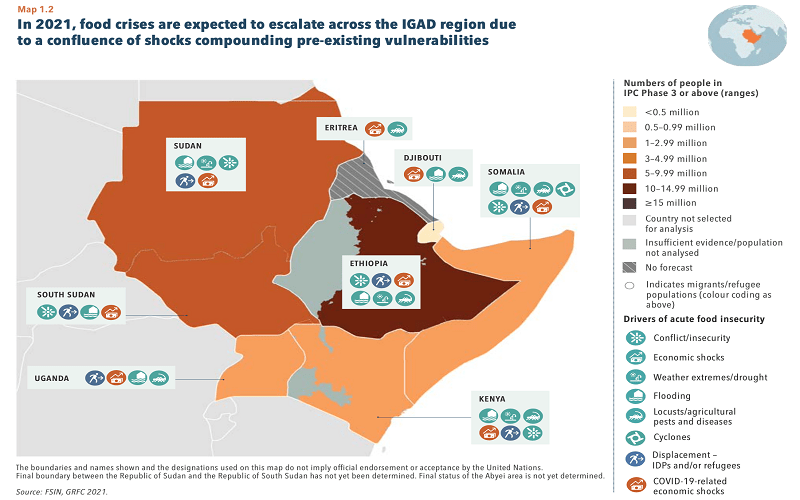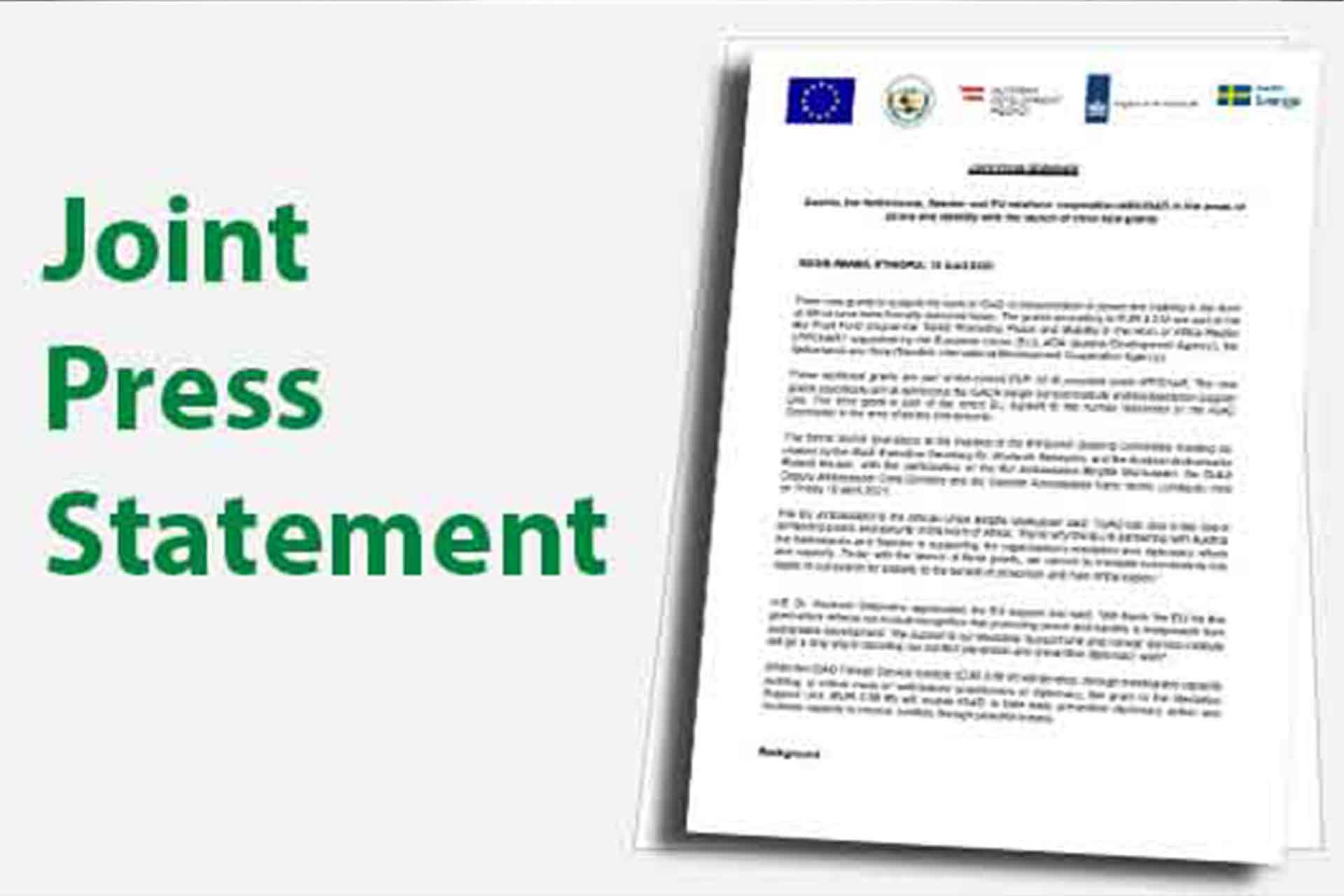PRESS RELEASE
September 21, 2021 Nairobi, Kenya: An estimated 31.4 million people across the IGAD region were classified in crisis or worse (IPC Phase 3+) levels of acute food insecurity in 2020. This figure represents 20% of the global 155 million people that faced food insecurity and required urgent action in 2020. 2021 projections point to a grimmer situation, where between 36.7 to 37.2 million people will likely face high levels of acute food insecurity (IPC Phase 3 or above), largely due to conflict, weather extremes, and persistent economic shocks (including the socio-economic repercussions of COVID-19).
The prevailing food security situation in the region was revealed during the launch of the Regional Focus on the Intergovernmental Authority on Development (IGAD) Member States of the 2021 Global Report on Food Crises (GRFC) that took place today. This report is the culmination of a joint analysis led by the Food Security Information Network (FSIN), under the Global Network Against Food Crises, that provides a comprehensive regional picture of the food security and nutritional situation.
The report indicates that the number of food insecure people (IPC Phase 3+) in the IGAD region has steadily increased from 26.8 million in 2017, to 27 million in 2018, 27.6 million in 2019 (excluding Djibouti), and up to 31.4 million in 2020.
“With 20 percent, of the global number of highly food insecure people in 2020 resident in the IGAD region, short-term humanitarian interventions alone are not enough. There is a need for us to initiate a paradigm shift to a longer-term view that inspires us to come up with coherent, coordinated, and cost-effective development investments that target the root-causes of food crises in our region. With proper forwarding planning, drought does not need to turn into famine and we can avert the chances of families sleeping hungry. With the forecast for a drier than usual season from October to December 2021, we call on our IGAD Member State governments, other regional, international, and key stakeholders, to work together in the spirit of multilateralism and global brotherhood to build efficient, effective, inclusive and resilient food systems, to mitigate the effects of drought, fend off the possibility of conflict thus supporting durable peace for the people of our IGAD region.” said Workneh Geneyehu, IGAD Executive Secretary.
“Given the worrying trends in this year’s report, we must continue concerted efforts that help support communities and individuals improve their food and nutrition security, and prevent them from falling into hunger. To do this, we need to support governments and communities to build resilient and sustainable agri-food systems. Improving the reach of extension services, peace building initiatives and market access, as well timely anticipatory and emergency humanitarian response to crises, must remain at the core of our collective response to build and protect farmers’ resilience to shocks and crises.” said David Phiri, Food and Agriculture Organization of the United Nations’ Subregional Coordinator for Eastern Africa.
“The East African region is one of the most food insecure regions of the world, with one in every five hungry people globally located here. Macro-economic shocks together with the COVID-19 pandemic, ongoing conflict, and drought in parts of Kenya, Somalia and Ethiopia have increased acute hunger far above levels previously experienced. These shocks do not just have immediate, short-term effects, they exacerbate prevailing food insecurity and undermine livelihoods and development gains that took years to build. We must continue to support vulnerable communities across the region and work with all stakeholders to address the root causes of conflict and hunger.” said Michael Dunford, World Food Programme Regional Director for Eastern Africa.
Key messages
- Three countries in the region were among the 10 worst global food crises – the Sudan with 9.6 million people in crisis or worse (IPC Phase 3 or above), Ethiopia with 8.6 million and South Sudan with 6.5 million. These three countries accounted for nearly 79 percent of the IGAD region’s population in crisis or worse (IPC Phase 3 or above).
- At any point in time in 2020 across the eight IGAD countries, an estimated 3.5 million children under 5 years were wasted, with 0.9 million requiring life-saving treatment for severe wasting. Ethiopia, Sudan, and South Sudan had the highest number of wasted children. Children with wasting are too thin and their immune systems are weak, leaving them vulnerable to developmental delays, disease and death. A further 14.1 million across six IGAD countries were stunted, with the highest numbers in Ethiopia, Sudan and Uganda.
- The region had over 4.2 million refugees and asylum seekers in 2020, an increase of 4 percent compared to the 4.04 million reported in 2019, and hosted around 9.5 million Internally Displaced People (IDPs) in Ethiopia, Somalia, the Sudan and South Sudan, representing 20% of the world’s 46 million IDPs in 2020. Around half of the refugees were from South Sudan and others from Somalia, the Democratic Republic of the Congo, the Sudan, Eritrea and Ethiopia.
- The information in the report provides agencies, governments and other key stakeholders with reliable collective data and analysis to inform coordinated and cost-efficient strategies to tackle the root causes of food crises in the region.
Call to action
- Provide immediate and adequate life-saving food, livelihood and nutrition support for populations projected to face high levels of acute food insecurity and malnutrition. Initiatives such as providing food, cash, and livelihood assistance, strengthening social protection systems, and improving availability of and access to quality curative and preventive nutrition services should all be scaled up.
- Continue monitoring the food security and nutrition situation, including the collection of data to inform analyses.
- Strengthen and support peace-building initiatives, such as social cohesion programmes, that aim to address the root causes of conflict and insecurity in the region.
- Summary IGAD 2021 Regional Report on Food Crises (RRFC)
- Full Report IGAD 2021 Regional Report on Food Crises (RRFC) More resources on Global Report on Food Crises (GRFC)
- Statement of the Global Network against Food Crises on the release of the Global Report on Food Crises 2021
- East Africa Hazards Watch
- East Africa Drought Watch
- Press Release GHACOF 59
- Summary for Decision Makers GHACOF 59
Media requests
- Wawira Njoka: IGAD Climate Centre (ICPAC), wawira.njoka@igad.int
- Gordon Weiss: WFP Regional Bureau for Eastern Africa, gordon.weiss@wfp.org
- Judith M. Mulinge: FAO Resilience Team for Eastern Africa, Judith.Mulinge@fao.org
Hashtags
#Fightfoodcrises
#IGAD #GRFC


